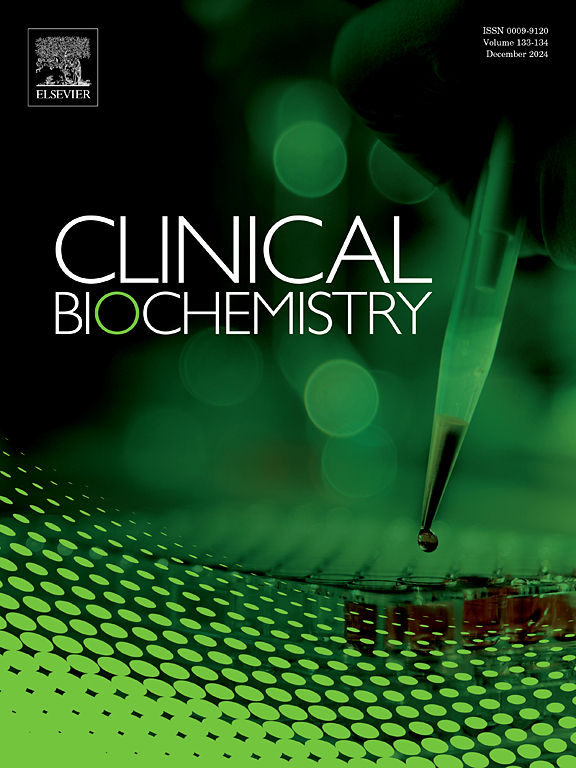血清蛋白电泳谱β区域的定量异常作为单克隆的预测标记:单克隆预测的机器学习。
IF 2.5
3区 医学
Q2 MEDICAL LABORATORY TECHNOLOGY
引用次数: 0
摘要
研究目的:开发一种机器学习算法,旨在预测β-球蛋白部分升高时单克隆(M-)蛋白的存在。材料和方法:选择2021年10月至2022年4月在布鲁塞尔大学医院实验室进行常规诊断程序的患者。包括血清蛋白电泳显示β1和/或β2含量升高的成年患者。选择是按照严格的排除标准进行的,如急性炎症、缺铁性贫血症状或假定的肝脏疾病。采用年龄、性别、β1和β2浓度(g/L)、总蛋白(g/L)、IgA、IgM、IgG值(g/L)和低丙种球蛋白血症等因素,构建单克隆预测阳性免疫固定(IFE)的预测模型。对数据集进行随机分割,分为基础训练集(80%,247个样本)和基础测试集(20%,62个样本)。训练集采用五种不同的算法:逻辑回归、决策树、随机森林、梯度增强和支持向量。结果:入选309例患者;单克隆的IFE阴性149个,阳性160个。通过对5个模型的评价,结果表明,随机森林模型具有较高的灵敏度(85%)和受试者工作特征曲线下面积(91%),因此选择了随机森林模型。结论:获得了一种准确预测β-球蛋白含量升高时M蛋白存在的算法,可提高单克隆γ病的早期诊断水平。本文章由计算机程序翻译,如有差异,请以英文原文为准。
Quantitative abnormalities in the β-region of the electrophoretic profile of serum proteins as predictive markers of monoclonality: Machine learning for monoclonality prediction
Objective of the study
To develop a machine learning algorithm aimed at predicting the presence of a monoclonal (M-) protein when the β-globulin fraction is elevated.
Materials and method
Patients were selected as part of the University Hospital Laboratory of Brussels routine diagnostic procedures from October 2021 to April 2022. Adult patients with serum protein electrophoresis showing elevated β1 and/or β2 fractions were included. The selection was done following strict exclusion criteria such as acute inflammation, iron deficiency anemia signs or supposed liver disease. To construct a predictive model for prediction of positive immunofixation (IFE) for monoclonality, the following factors were used: age, sex, β1 and β2 concentration (g/L), total proteins (g/L), IgA, IgM, IgG values (g/L) and hypogammaglobulinemia. The dataset underwent a random split, divided into a foundational training set (80%, 247 samples) and a foundational test set (20%, 62 samples). The training sets were subjected to five different algorithms: logistic regression, decision tree, random forest, gradient boosting, and support vector.
Results
309 patients were selected; 149 exhibited a negative IFE and 160 a positive IFE for monoclonality. The evaluation of the five tested models demonstrated very good performance, the chosen model was Random Forest for its high sensitivity (85%) and area under the receiver operating characteristic curve (91%).
Conclusion
An accurate algorithm was achieved for predicting the presence of M protein when the β-globulin fraction is elevated which enables early and improved diagnosis of monoclonal gammopathy.
求助全文
通过发布文献求助,成功后即可免费获取论文全文。
去求助
来源期刊

Clinical biochemistry
医学-医学实验技术
CiteScore
5.10
自引率
0.00%
发文量
151
审稿时长
25 days
期刊介绍:
Clinical Biochemistry publishes articles relating to clinical chemistry, molecular biology and genetics, therapeutic drug monitoring and toxicology, laboratory immunology and laboratory medicine in general, with the focus on analytical and clinical investigation of laboratory tests in humans used for diagnosis, prognosis, treatment and therapy, and monitoring of disease.
 求助内容:
求助内容: 应助结果提醒方式:
应助结果提醒方式:


